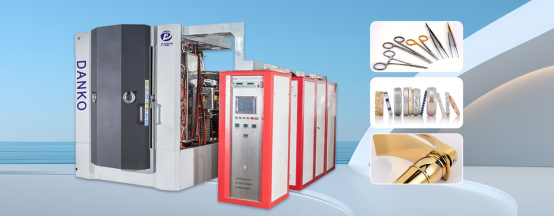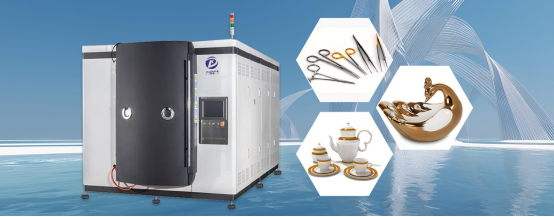Zhejiang Ningbo, China, 21st Oct 2025– Danko Vacuum Technology Co., Ltd, a leading innovator in surface engineering, today announced the launch of its enhanced portfolio of Physical Vapor Deposition (PVD) coating machines. This new line is engineered to address the global market’s rising demand for products with unprecedented durability, superior aesthetic quality, and environmentally responsible manufacturing processes. As a cornerstone asset for forward-thinking companies, Danko’s PVD coating machines empower manufacturers in the automotive, electronics, jewelry, and medical sectors to control quality, accelerate innovation, and gain a decisive competitive edge.

In a global market demanding unprecedented levels of product performance, durability, and aesthetic excellence, manufacturers are increasingly turning to advanced surface engineering. At the forefront of this industrial evolution is Physical Vapor Deposition (PVD), and the sophisticated engine driving it: the PVD coating machine. No longer a niche technology for high-end research, the PVD coating machine has become a cornerstone asset for forward-thinking companies seeking to control quality, accelerate innovation, and deliver superior products in sectors ranging from automotive and aerospace to consumer electronics and medical devices.
This press release delves into the core principles, features, applications, and strategic advantages of modern PVD technology, and explores the typical PVD coating machines that are empowering businesses to build a competitive edge from the surface up.
Principle of PVD Coating Machine
The PVD (Physical Vapor Deposition) coating process works on a straightforward yet powerful principle:
Solid coating materials are transformed into vapor or plasma inside a high-vacuum chamber, then deposited directly onto the product’s surface (substrate) to form a dense, strongly adherent film.
Core Steps in the Process:
1.Surface Cleaning – Removes contaminants to ensure maximum bonding between the coating and substrate.
2.Vacuum Environment Creation – Maintains a clean, contamination-free space for precise coating deposition.
3.Material Vaporization – Uses high-energy methods such as arc evaporation or magnetron sputtering to release atoms from the coating target material.
4.Reactive Gas Introduction – Incorporates gases like nitrogen (N₂) or oxygen (O₂) to form specialized coatings such as titanium nitride (TiN) or chromium nitride (CrN).
5.Controlled Deposition – Fine-tunes parameters like temperature, electrical power, and time to achieve the desired coating thickness and physical properties.
This physical deposition method creates coatings with exceptional density, hardness, adhesion, and performance characteristics—significantly surpassing traditional electroplating or painting methods.
Key Features of PVD Coating Machines
Modern PVD coating machines come with a suite of high-tech engineering features designed to meet industry requirements:
1.Advanced Vacuum Systems – Capable of achieving and maintaining high vacuum levels for optimal coating quality.
2.Multi-Source Capability – Allows simultaneous use of multiple coating sources (arc and sputtering) for hybrid coatings.
3.Uniform Coating Deposition – Ensures an even finish across complex shapes and large production batches.
4.Color Customization – Enables production of coatings in gold, rose gold, black, silver, and even custom hues.
5.Energy Efficiency – Reduces operational costs while lowering environmental impact.
6.Programmable Control Panels – Offers precise process control and repeatability for large-scale manufacturing.
7.Compact & Modular Design – Facilitates easy integration into existing production lines.
Applications Across Industries
The versatility of PVD coating machines makes them a valuable asset in countless industries:
1.Jewelry – Adds luxurious finishes like gold, rose gold, and black with superior wear resistance, preventing scratches and tarnish.
2.Watches – Enhances long-term aesthetics and durability of cases, bezels, and bands.
3.Glass and Architectural Materials – Provides functional coatings for solar control, scratch resistance, and decorative appeal in buildings and cars.
4.Ceramics – Improves impact resistance while allowing vibrant, customizable colors.
5.Industrial Tools – PVD tools coating for increasing hardness, high-temperature stability, and lifespan of cutting tools, molds, and machine components.
6.Medical Instruments – Offers biocompatible coatings suitable for surgical tools, implants, and devices.
7.Electronics – Produces wear-resistant and conductive layers for semiconductors, sensors, and display panels.

Advantages Over Traditional Methods
Compared with electroplating, painting, or thermal spraying, PVD coating machines deliver unique benefits:
High Wear Resistance – Dense films with superior hardness protect against abrasion and mechanical stress.
Eco-Friendly Process – Eliminates toxic chemical baths and reduces hazardous waste output.
Aesthetic Versatility – Offers an extensive range of colors, finishes, and textures without compromising performance.
Material Compatibility – Works on metals, ceramics, glass, and composite materials.
Biocompatibility – Safe for contact with human skin, medical equipment, and food-handling tools.
Thin yet Strong Coatings – Achieves performance with minimal weight addition, ideal for precision components.
Typical PVD Coating Machine Types
Modern PVD coating machines are classified primarily by their physical deposition method:
1. Arc Evaporation PVD Machines
Principle: Generates a high-current, low-voltage arc to vaporize the target material.
Advantages: Extremely dense and hard coatings, excellent adhesion, and fast deposition rates.
Applications: Commonly used for TiN coatings on cutting tools, molds, and decorative products.
2. Magnetron Sputtering PVD Machines
Principle: Uses plasma to eject atoms from the target material via kinetic energy, depositing them on substrates.
Advantages: Produces coatings with precise thickness control, high uniformity, and smooth surfaces.
Applications: Ideal for electronics, optical components, architectural glass, and decorative films.
3. Hybrid PVD Machines
Principle: Combines arc evaporation and sputtering in a single system.
Advantages: Offers the best of both worlds—high adhesion from arc deposition and high smoothness from sputtering.
Applications: Versatile across industries, covering both technical and decorative coating needs.
About Danko Vacuum Technology Co.,Ltd
Danko Vacuum Technology Co.,Ltd is a leading innovator and provider of advanced PVD coating solutions. We specialize in designing, manufacturing, and supporting a complete range of PVD coating machines, from standard models to fully customized systems. Our mission is to empower manufacturers with the surface engineering technology they need to lead their industries in quality, performance, and sustainability.
To learn more about how a PVD coating machine can revolutionize your production process, please visit our website or contact our team for a consultation.
Media Contact
Organization: Danko Vacuum Technology Co.,Ltd
Contact Person: Peter
Website: https://pvdvacuumcoating.com
Email: Send Email
Address:No. 79 West Jinniu Road, Yuyao, Ningbo City, Zhejiang Provice, China
City: Zhejiang Ningbo
Country:China
Release id:35783
The post PVD Coating Machine Redefining Surface Technology for a Durable and Sustainable Future appeared first on King Newswire. This content is provided by a third-party source.. King Newswire makes no warranties or representations in connection with it. King Newswire is a press release distribution agency and does not endorse or verify the claims made in this release. If you have any complaints or copyright concerns related to this article, please contact the company listed in the ‘Media Contact’ section
Disclaimer: The views, suggestions, and opinions expressed here are the sole responsibility of the experts. No Clear Bulletin journalist was involved in the writing and production of this article.
